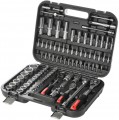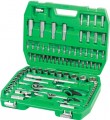Square drive size
The size of the "seat" for which the socket heads included in the package are designed (see below), in other words, the size of the square hole on the back of the head used for installation on a ratchet, wrench or other similar tool. Accordingly, the tool for working with heads supplied in the kit has the same dimensions of the landing square; and in the absence of such tools in the kit, data on the size of the heads will be useful for its selection.
There is a generally accepted standard for these sizes, providing for the designation in fractions of an inch — from 1/4 "to 1". Thanks to this, heads and tools from different sets can be quite compatible — just matching in size is enough. Most often in modern hand sets there are options in 1/4 "and 1/2", a little less often — 3/4" and 3/8". Some sets include several variants of the landing square at once.
Bits
The number of
bits supplied with the tool kit.
A bat in this case is called a working nozzle, which plays the role of a screwdriver tip; in fact, they are most often used with screwdriver handles (see above).
Many types of splines (slots) are used in modern fasteners — starting with the well-known
straight, cross-shaped (
Phillips and
Pozidriv),
Torx sprockets and ending with exotics like Torq-set (a cross with lines shifted from the centre), Pentalobe (with five ledges), etc. .P. In addition, the size of the slots can also vary, and in many cases, tool matching in size is very important. Accordingly, the more bits supplied with the set, the more versatile it is, the higher the probability that it will contain a nozzle of the desired type and size. However, the specific list of bits in the kit also does not hurt to clarify — in order to make sure that it has all the varieties you need. In the characteristics of individual sets, these data are given in the paragraph "Bit sizes" (see below).
Bit sizes
Varieties of bits (see above) included in the set.
Note that this paragraph specifies not just the size, but also the type of slot for which this or that bit is designed. This type is indicated by a letter index followed by a number describing the size — for example, SL5. Here are the most popular designations found in modern bits:
— SL. Flat bits for straight slot. The size is indicated in millimetres.
— Ph. Classic cross bits. The size is indicated by a conditional number.
— P.Z. Bits for a modified cross slot with improved engagement, have additional edges. The size is indicated by a conditional number.
— TX, T. Torx bits, with six-pointed sprocket tips. The size is indicated by a conditional number.
— H. Hex bits, with hex tips. The size is indicated in millimetres.
If there is more than one bit of a certain type in the set, the number is specified after the designation, for example, PH2x2.
Adapter
An adapter for docking seemingly incompatible elements from a set. For example, socket heads with an unsuitable landing square on a ratchet, screwdriver handle or in a drill driver.
The adapter provides full-fledged work with all the required list of tools from the set.
Hex wrenches size
Working size range of hex wrench sizes (see above) supplied with the kit. This parameter allows you to evaluate how the keys fit the dimensions of the fasteners with which they are planned to be used.
Dimensions
The dimensions of the entire set, namely the case, lodgment, cassette, etc. storage accessory (see paragraph above) with tools installed inside. Allows you to understand how much space the model will occupy and whether it can be placed in a complete set in one place or another.
Weight
The total weight of the tool kit. Indicated with a case, stand or other storage/transportation device (see Tool Storage). First of all, you should pay attention to this parameter if you plan to often carry the kit over long distances — the lighter the weight, the easier it will be to do. At the same time, extensive sets inevitably turn out to be weighty.

